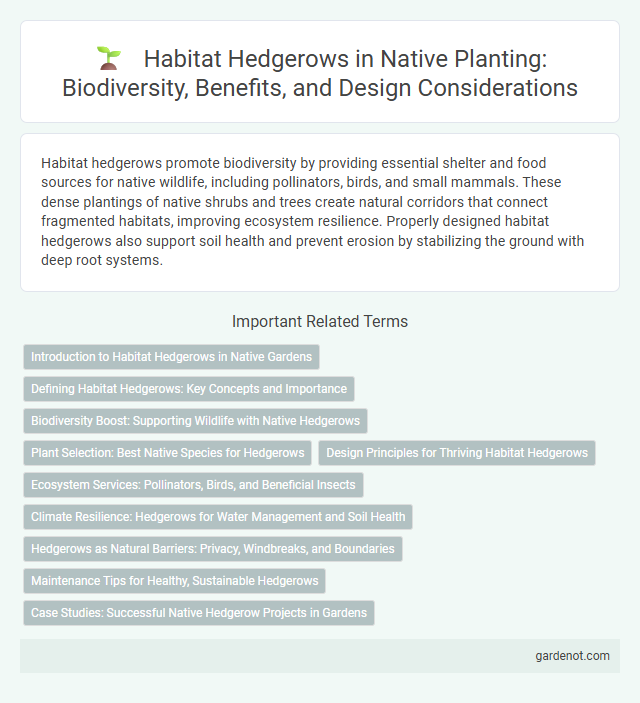Habitat hedgerows promote biodiversity by providing essential shelter and food sources for native wildlife, including pollinators, birds, and small mammals. These dense plantings of native shrubs and trees create natural corridors that connect fragmented habitats, improving ecosystem resilience. Properly designed habitat hedgerows also support soil health and prevent erosion by stabilizing the ground with deep root systems.
Introduction to Habitat Hedgerows in Native Gardens
Habitat hedgerows are essential components in native gardens, providing critical shelter and food sources for local wildlife such as birds, pollinators, and beneficial insects. These dense, multi-layered plantings typically feature native shrubs, grasses, and flowering plants that create diverse microhabitats and promote ecosystem resilience. Incorporating habitat hedgerows enhances biodiversity, supports natural pest control, and fosters a sustainable garden environment that aligns with regional ecological conditions.
Defining Habitat Hedgerows: Key Concepts and Importance
Habitat hedgerows are linear plantings composed primarily of native species designed to support biodiversity by providing shelter, food, and corridors for wildlife movement. These hedgerows enhance ecosystem connectivity, improve soil health, and contribute to carbon sequestration. Understanding their ecological functions is essential for conservation efforts and sustainable land management.
Biodiversity Boost: Supporting Wildlife with Native Hedgerows
Native hedgerows provide a critical habitat that supports diverse wildlife, enhancing local biodiversity by offering food, shelter, and nesting sites for birds, insects, and small mammals. These plantings promote ecological balance by attracting pollinators such as bees and butterflies, which are essential for ecosystem health and plant reproduction. Incorporating native species in hedgerows strengthens natural resilience against pests and diseases while creating corridors that facilitate wildlife movement across fragmented landscapes.
Plant Selection: Best Native Species for Hedgerows
Selecting native species such as American hazelnut, elderberry, and spicebush for habitat hedgerows enhances biodiversity by providing essential food and shelter for local wildlife. These plants thrive in regional soil and climate conditions, promoting ecosystem resilience and reducing maintenance requirements. Incorporating diverse native shrubs and small trees creates layered vegetation that supports pollinators, birds, and beneficial insects throughout the growing season.
Design Principles for Thriving Habitat Hedgerows
Design principles for thriving habitat hedgerows emphasize native plant selection to support local wildlife and enhance biodiversity. Incorporating diverse layers of vegetation, including trees, shrubs, and groundcovers, creates structural complexity that provides shelter and food resources. Strategic placement considers sunlight, soil type, and connectivity to existing habitats to maximize ecological benefits and promote resilient ecosystems.
Ecosystem Services: Pollinators, Birds, and Beneficial Insects
Habitat hedgerows composed of native plants provide crucial ecosystem services by supporting diverse pollinators such as bees and butterflies, which enhance local biodiversity and crop pollination. These hedgerows offer essential nesting and foraging habitats for birds, improving avian populations and contributing to natural pest control. Beneficial insects thrive in these environments, promoting ecological balance and reducing reliance on chemical pesticides in surrounding agricultural or garden landscapes.
Climate Resilience: Hedgerows for Water Management and Soil Health
Habitat hedgerows contribute significantly to climate resilience by enhancing water management through natural filtration and runoff reduction, preventing soil erosion, and improving moisture retention. These native plant structures support soil health by increasing organic matter, promoting microbial diversity, and stabilizing the soil ecosystem against extreme weather events. Incorporating native species in hedgerows boosts ecosystem services that mitigate flood risks and maintain groundwater quality.
Hedgerows as Natural Barriers: Privacy, Windbreaks, and Boundaries
Habitat hedgerows composed of native plants serve as natural barriers that enhance privacy while reducing wind impact and defining property boundaries. These dense, multi-species plantings create critical wildlife corridors, supporting biodiversity by providing shelter and food sources for birds, insects, and small mammals. By integrating native species suited to local conditions, habitat hedgerows offer sustainable, low-maintenance solutions that strengthen ecosystem resilience and landscape connectivity.
Maintenance Tips for Healthy, Sustainable Hedgerows
Regular pruning of native habitat hedgerows encourages dense growth and prevents overcrowding, promoting a healthy ecosystem. Mulching with organic materials helps retain soil moisture and suppresses weeds, reducing competition for nutrients. Monitoring for pests and diseases early ensures timely treatment, supporting long-term sustainability of the hedgerow.
Case Studies: Successful Native Hedgerow Projects in Gardens
Case studies of successful native hedgerow projects in gardens demonstrate significant benefits for local wildlife and ecosystem stability. Native plant species such as hawthorn, blackthorn, and dogwood provide essential habitats for pollinators, birds, and small mammals while enhancing soil health through natural nitrogen fixation. These projects often result in increased biodiversity, improved pest control, and reduced maintenance compared to non-native hedgerows.
Habitat hedgerow Infographic

 gardenot.com
gardenot.com